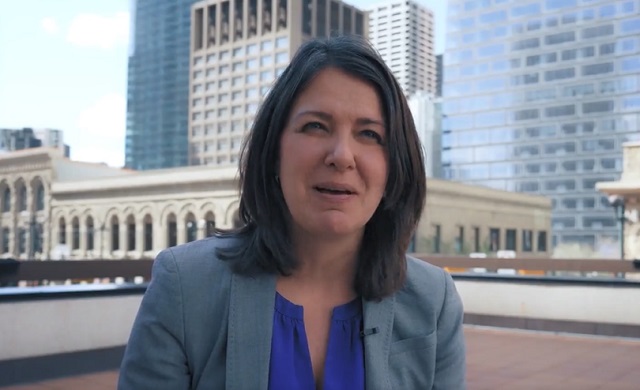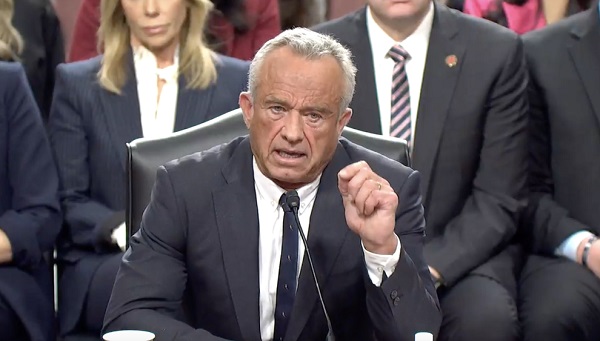Alberta
Danielle Smith slams Trudeau’s methane emissions rules as ‘unrealistic,’ ‘unconstitutional’

From LifeSiteNews
‘Instead of building on Alberta’s award-winning approach, Ottawa wants to replace it with costly, dangerous and unconstitutional new federal regulations that won’t benefit anyone beyond Environment and Climate Change Minister Steven Guilbeault’s post-office career,’ a joint statement read
Alberta Premier Danielle Smith condemned the Trudeau government’s methane emissions cap as “unrealistic” and “unconstitutional.”
On December 4, Smith and Minister of Environment and Protected Areas Rebecca Schulz issued a joint statement blasting Environment Minister Steven Guilbeault’s new draft methane regulations.
“The federal government has unilaterally established new methane emissions rules and targets to help win international headlines,” the joint statement read.
“Instead of building on Alberta’s award-winning approach, Ottawa wants to replace it with costly, dangerous and unconstitutional new federal regulations that won’t benefit anyone beyond Environment and Climate Change Minister Steven Guilbeault’s post-office career,” it continued.
The proposed regulations, drafted December 4 after the 2023 United Nations Climate Change Conference (COP28) in Dubai, restrict oil and gas methane emissions to allegedly reduce “climate change.”
“The proposed methane regulations are consistent with Canada’s commitment to cap and cut oil and gas emissions and with calls from the International Energy Agency for all oil- and gas-producing countries to reduce methane emissions from the sector by 75 percent by 2030,” the news release read.
Under the proposed plan, methane regulations must reduce by 217 megatonnes (carbon dioxide equivalent) from 2027 to 2040.
“Canada is on track to meet its 2025 methane reduction target of 40 to 45 percent below 2012 levels,” the statement asserted. “The draft regulations published today are amendments to the 2018 methane regulations.”
In response to the regulations, Smith pointed out that Alberta has the autonomy to determine its own climate regulations without the direction of the Liberal government under the leadership of Prime Minister Justin Trudeau.
“Managing emissions from Alberta’s oil and gas industry is our constitutional right and responsibility, not Ottawa’s, and we are getting the job done,” Smith declared. “Using a province-led approach, Alberta has already reduced methane emissions from the oil and gas sector by 45 percent – hitting our target three years early – and we’re just getting started.”
“Meanwhile, not only is it illegal for Ottawa to attempt to regulate our industries in this manner, Ottawa also hasn’t even hit one of its past arbitrary and unscientific emissions targets,” she revealed.
“Once again, the federal government is setting unrealistic targets and timelines,” Smith added. “Infrastructure can only be updated as quickly as technology allows. For example, Alberta will not accept nor impose a total ban on flaring at this time, as it is a critical health and safety practice during production.”
“Given the unconstitutional nature of this latest federal intrusion into our provincial jurisdiction, our government will use every tool at our disposal to ensure these absurd federal regulations are never implemented in our province,” Smith concluded.
This is hardly the first time Smith has defended Alberta from Trudeau’s climate regulations. Smith has repeatedly asserted Alberta’s right to control power grid, promising the province will not be “transitioning away” from oil and natural gas.
Smith has warned that Canadians could freeze in the winter if the new “clean emissions” regulations are enforced, an assertion supported by Alberta’s electric grid operator, Alberta Electric System Operator (AESO), which warned that Trudeau’s 2035 net-zero power grid goal will mean instability for the western province and are “not feasible.”
Two recent court rulings dealt a serious blow to the Trudeau government’s environmental activism via legislation. The most recent was in November when the Federal Court of Canada ruled in favor of Alberta and Saskatchewan and overturned the Trudeau government’s ban on single-use plastic, calling it “unreasonable and unconstitutional.”
The second victory for Alberta and Saskatchewan concerns a Supreme Court ruling that stated that Trudeau’s law, C-69, dubbed the “no-more pipelines” bill, is “mostly unconstitutional.” The decision returned authority over the pipelines to provincial governments, meaning oil and gas projects headed up by the provinces should be allowed to proceed without federal intrusion.
In May, Guilbeault declared that violating environmental regulations banning the use of coal and gas-fired power after 2035 may even result in criminal sanctions, a statement that only increased the tension between the federal government and the provinces opposed to the proposed policies.
Alberta
Red Deer Justice Centre Grand Opening: Building access to justice for Albertans

The new Red Deer Justice Centre will help Albertans resolve their legal matters faster.
Albertans deserve to have access to a fair, accessible and transparent justice system. Modernizing Alberta’s courthouse infrastructure will help make sure Alberta’s justice system runs efficiently and meets the needs of the province’s growing population.
Alberta’s government has invested $191 million to build the new Red Deer Justice Centre, increasing the number of courtrooms from eight to 12, allowing more cases to be heard at one time.
“Modern, accessible courthouses and streamlined services not only strengthen our justice
system – they build safer, stronger communities across the province. Investing in the new Red Deer Justice Centre is vital to helping our justice system operate more efficiently, and will give people in Red Deer and across central Alberta better access to justice.”

Government of Alberta and Judiciary representatives with special guests at the Red Deer Justice Centre plaque unveiling event April 22, 2025.
On March 3, all court services in Red Deer began operating out of the new justice centre. The new justice centre has 12 courtrooms fully built and equipped with video-conference equipment to allow witnesses to attend remotely if they cannot travel, and vulnerable witnesses to testify from outside the courtroom.
The new justice centre also has spaces for people taking alternative approaches to the traditional courtroom trial process, with the three new suites for judicial dispute resolution services, a specific suite for other dispute resolution services, such as family mediation and civil mediation, and a new Indigenous courtroom with dedicated venting for smudging purposes.
“We are very excited about this new courthouse for central Alberta. Investing in the places where people seek justice shows respect for the rights of all Albertans. The Red Deer Justice Centre fills a significant infrastructure need for this rapidly growing part of the province. It is also an important symbol of the rule of law, meaning that none of us are above the law, and there is an independent judiciary to decide disputes. This is essential for a healthy functioning democracy.”
“Public safety and access to justice go hand in hand. With this investment in the new Red Deer Justice Centre, Alberta’s government is ensuring that communities are safer, legal matters are resolved more efficiently and all Albertans get the support they need.”
“This state-of-the-art facility will serve the people of Red Deer and surrounding communities for generations. Our team at Infrastructure is incredibly proud of the work done to plan, design and build this project. I want to thank everyone, at all levels, who helped make this project a reality.”
Budget 2025 is meeting the challenge faced by Alberta with continued investments in education and health, lower taxes for families and a focus on the economy.

Quick facts
- The new Red Deer Justice Centre is 312,000 sq ft (29,000 m2). (The old courthouse is 98,780 sq ft (9,177 m2)).
- The approved project funding for the Red Deer Justice Centre is about $191 million.
Alberta
Made in Alberta! Province makes it easier to support local products with Buy Local program

Show your Alberta side. Buy Local. |
When the going gets tough, Albertans stick together. That’s why Alberta’s government is launching a new campaign to benefit hard-working Albertans.
Global uncertainty is threatening the livelihoods of hard-working Alberta farmers, ranchers, processors and their families. The ‘Buy Local’ campaign, recently launched by Alberta’s government, encourages consumers to eat, drink and buy local to show our unified support for the province’s agriculture and food industry.
The government’s ‘Buy Local’ campaign encourages consumers to buy products from Alberta’s hard-working farmers, ranchers and food processors that produce safe, nutritious food for Albertans, Canadians and the world.
“It’s time to let these hard-working Albertans know we have their back. Now, more than ever, we need to shop local and buy made-in-Alberta products. The next time you are grocery shopping or go out for dinner or a drink with your friends or family, support local to demonstrate your Alberta pride. We are pleased tariffs don’t impact the ag industry right now and will keep advocating for our ag industry.”
Alberta’s government supports consumer choice. We are providing tools to help folks easily identify Alberta- and Canadian-made foods and products. Choosing local products keeps Albertans’ hard-earned dollars in our province. Whether it is farm-fresh vegetables, potatoes, honey, craft beer, frozen food or our world-renowned beef, Alberta has an abundance of fresh foods produced right on our doorstep.
Quick facts
- This summer, Albertans can support local at more than 150 farmers’ markets across the province and meet the folks who make, bake and grow our food.
- In March 2023, the Alberta government launched the ‘Made in Alberta’ voluntary food and beverage labelling program to support local agriculture and food sectors.
- Through direct connections with processors, the program has created the momentum to continue expanding consumer awareness about the ‘Made in Alberta’ label to help shoppers quickly identify foods and beverages produced in our province.
- Made in Alberta product catalogue website
Related information
-

 Business2 days ago
Business2 days agoTrump: China’s tariffs to “come down substantially” after negotiations with Xi
-

 Business2 days ago
Business2 days agoTrump considers $5K bonus for moms to increase birthrate
-

 Business2 days ago
Business2 days agoChinese firm unveils palm-based biometric ID payments, sparking fresh privacy concerns
-

 COVID-192 days ago
COVID-192 days agoRFK Jr. Launches Long-Awaited Offensive Against COVID-19 mRNA Shots
-

 Business1 day ago
Business1 day agoIs Government Inflation Reporting Accurate?
-

 2025 Federal Election1 day ago
2025 Federal Election1 day agoConservatives promise to ban firing of Canadian federal workers based on COVID jab status
-

 2025 Federal Election1 day ago
2025 Federal Election1 day agoCarney’s Hidden Climate Finance Agenda
-

 International1 day ago
International1 day agoPope Francis Got Canadian History Wrong





